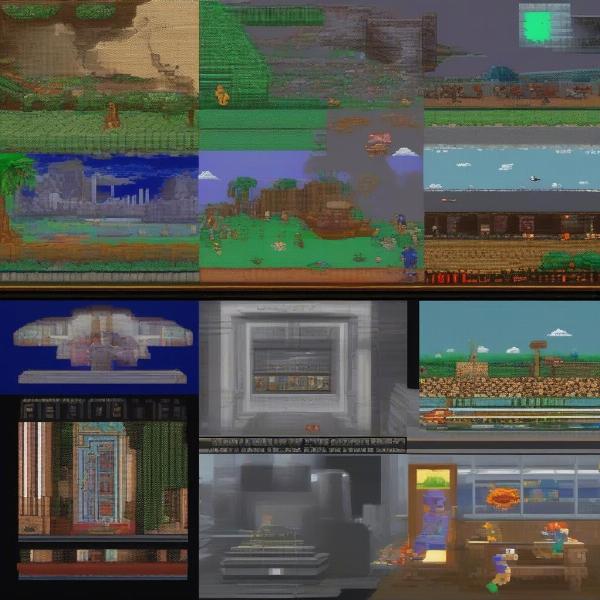Computer science has revolutionized the gaming industry, transforming it from simple pixelated sprites to immersive, realistic worlds. This evolution is a testament to the powerful synergy between creativity and technological advancements driven by computer science principles. From the underlying algorithms that govern game mechanics to the sophisticated graphics that bring virtual worlds to life, computer science’s impact on gaming is undeniable and continues to shape the future of interactive entertainment.
The Foundational Role of Algorithms
At the heart of every video game lies a complex network of algorithms. These sets of instructions dictate how everything from character movement and AI behavior to physics simulations and game logic functions. Computer science provides the tools and methodologies to develop efficient and elegant algorithms, making games more responsive, challenging, and engaging. Early games relied on simpler algorithms, but with the advancement of computer science, we now see complex AI opponents, realistic physics engines, and procedural generation of game worlds.
Imagine playing a classic platformer like Super Mario Bros. The seemingly simple act of Mario jumping is governed by algorithms calculating gravity, momentum, and collision detection. Now, contrast that with the intricate physics simulations in a modern racing game, where every detail from tire grip to aerodynamic drag is meticulously modeled. This evolution demonstrates how advancements in computer science have enabled increasingly sophisticated game mechanics.
 Algorithms Powering Complex Game Mechanics
Algorithms Powering Complex Game Mechanics
Graphics: From Pixels to Photorealism
The visual transformation of video games is perhaps the most visible impact of computer science. From the blocky pixels of early arcade games to the breathtakingly realistic graphics of today’s AAA titles, the journey has been marked by continuous innovation in computer graphics techniques. Computer science research in areas like rendering, shading, and texture mapping has enabled developers to create visually stunning and immersive worlds that blur the lines between reality and virtuality.
Consider the evolution of character models. Early games featured simple, low-polygon models with limited animation capabilities. Now, thanks to advancements in computer graphics and animation techniques, characters are rendered with incredible detail, displaying realistic facial expressions, fluid movements, and intricate clothing simulations. This progress highlights the transformative power of computer science in enhancing the visual fidelity of games.
 Evolution of Video Game Graphics from Pixels to Photorealism
Evolution of Video Game Graphics from Pixels to Photorealism
Networking and Multiplayer Experiences
Computer science has not only revolutionized the single-player experience but has also fundamentally changed how we connect and play together. Online multiplayer gaming, now a cornerstone of the industry, owes its existence to advancements in networking technologies and distributed computing. Computer science principles underpin the development of robust and scalable servers, efficient communication protocols, and sophisticated matchmaking systems that enable millions of players worldwide to interact seamlessly in shared virtual environments.
Think about massive multiplayer online role-playing games (MMORPGs). These games rely on intricate networking infrastructure to handle thousands of players interacting simultaneously, sharing a persistent virtual world. The ability to seamlessly connect and collaborate with players across the globe is a direct result of advancements in computer science and networking.
 Connecting Players Through Online Multiplayer Gaming
Connecting Players Through Online Multiplayer Gaming
The Future of Gaming with AI and Machine Learning
Looking ahead, computer science continues to push the boundaries of what’s possible in gaming. Artificial intelligence (AI) and machine learning are poised to play increasingly significant roles in shaping the future of interactive entertainment. These technologies have the potential to create more dynamic and responsive game worlds, populate them with intelligent non-player characters (NPCs), and personalize the gaming experience for each individual player.
Imagine NPCs that learn and adapt to player behavior, creating unique and unpredictable challenges. Or consider games that procedurally generate content based on player preferences, offering endless replayability. These are just a few examples of how AI and machine learning, powered by computer science, are poised to revolutionize the gaming landscape.
Beyond the Screen: Virtual and Augmented Reality
Computer science is also driving the emergence of new gaming platforms like virtual reality (VR) and augmented reality (AR). These immersive technologies offer entirely new ways to interact with virtual worlds, blurring the lines between the digital and physical realms. VR immerses players completely in virtual environments, while AR overlays digital content onto the real world, creating unique and engaging gaming experiences. The development of these platforms relies heavily on advancements in computer graphics, sensor technology, and human-computer interaction, all areas rooted in computer science.
Conclusion
From the underlying algorithms that govern game mechanics to the cutting-edge technologies that power immersive virtual worlds, computer science has profoundly impacted games. How Has Computer Science Impacted Games? It’s a question with a multifaceted answer, showcasing a journey of constant innovation and transformation. As computer science continues to advance, we can expect even more groundbreaking changes in the gaming industry, pushing the boundaries of interactive entertainment and blurring the lines between reality and virtuality.
FAQ
-
What is the role of algorithms in video games?
Algorithms are the sets of instructions that dictate the rules and logic of a game, controlling everything from character movement to AI behavior. -
How has computer graphics impacted video games?
Computer graphics has enabled the evolution from simple pixelated visuals to the photorealistic graphics we see in modern games, creating immersive and visually stunning worlds. -
How does computer science facilitate online multiplayer gaming?
Computer science provides the networking technologies and distributed computing infrastructure necessary for online multiplayer games, allowing players to connect and interact seamlessly. -
What is the future of computer science in gaming?
AI, machine learning, VR, and AR are some of the key areas where computer science is expected to further revolutionize the gaming experience, creating more dynamic, personalized, and immersive interactive entertainment. -
What is the significance of computer science in game development?
Computer science provides the foundational principles and tools that enable the creation of complex, engaging, and visually stunning video games, driving innovation and shaping the future of the industry. -
How has computer science impacted the game industry’s business model?
Computer science has facilitated the rise of digital distribution, in-app purchases, and subscription services, transforming the way games are sold and monetized. -
What are some examples of computer science principles used in game development?
Data structures, algorithms, object-oriented programming, computer graphics, and artificial intelligence are just a few examples of computer science principles used extensively in game development.

